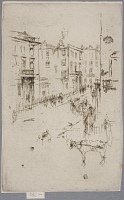Etchings Institutions search term: caxton club
Alderney Street | ||
| Number: | 246 | |
| Date: | 1881 | |
| Medium: | etching | |
| Size: | 180 x 113 mm | |
| Signed: | butterfly at upper right | |
| Inscribed: | no | |
| Set/Publication: | 'Gazette des Beaux-Arts', 1881 | |
| No. of States: | 3 | |
| Known impressions: | 35 | |
| Catalogues: | K.238; M.236; W.196 | |
| Impressions taken from this plate (35) | ||
PUBLICATION
 ). 14
). 14
Louis Gonse (1846-1921) had originally asked Whistler for an etching to be printed for Gazette des Beaux-Arts on 7 February 1878; this letter plus Whistler's reply, in which he claimed that without more money he could not possibly afford to be published in the Gazette des Beaux-Arts, were reprinted by Whistler as 'The Opportunity Neglected' in The Gentle Art of Making Enemies. 15
REPRODUCTION
An electrotype reproduction with the title 'A Street in London' was published in 1885 by Sylvester Rosa Koehler (1837-1900) in his book on etching, over the type-set title 'A Street in London', opposite Koehler's description of the plate. 16 This edition is common in libraries and public collections, and is frequently seen for sale. It has an even background tone, slightly glossy surface, and is printed slightly within the edges of the plate in black on heavy-weight ivory laid paper, sometimes darkened to cream or buff, with a sheet size of ca 343 x 240 mm. 17 It was reproduced from the Gazette des Beaux-Arts impression, with the clean-wiped band along the plate edges, which is not found in pencil-signed impressions of any state. 18 One of these electrotypes was added to the collection of Boston Museum of Fine Arts while Koehler was curator of prints (
 ). There are a number of the electrotypes in public collections, and several examples are included in our catalogue (i.e.
). There are a number of the electrotypes in public collections, and several examples are included in our catalogue (i.e.  , reproduced below). 19
, reproduced below). 19
14: Duret 1881 .
15: GUW #01650; Whistler 1890 , pp. 181-83.
16: Koehler 1885 , p. 162.
17: These electrotypes have sometimes been trimmed so the sheet size is smaller.
18: In these reproductions, there is a squiggly thread or hair in the image at upper left that must have been on the plate/negative. The small scratches that appear in the first three states of the etching, do not appear in the reproduction.
19: The identical electrotype may have been printed without the lettering, but details have not been confirmed.
20: The 1880 book is in a larger format, with pages measuring 428 x 306 mm.
EXHIBITIONS
21: London FAS 1883 (cat. no. 33). See REFERENCES : EXHIBITIONS.
22: 'Mr. Whistler's Exhibition', Saturday Review, 24 February 1883 (GUL PC 25/32); 'Mr. Whistler's Etchings', Globe, 19 February 1883 (GUL PC 25/19).
23: Knowledge, III, 6 April 1883, pp. 208-9, repr.
 ). 24
). 24
Following Whistler's death impressions were exhibited in the major Memorial Exhibitions including the Grolier Club, New York, in 1904. King Edward VII lent another to the Whistler Memorial Exhibition in London in 1905. 25
24: Chicago 1900 (cat. no. 174).
25: New York 1904a (cat. no. 198); London Mem. 1905
SALES & COLLECTORS
 ).
).An impression of 'Alderney Street' was sold by Whistler on 22 October 1886 to the London print dealer Thomas M. McLean (b. ca 1832) for £5.5.0. 26
 ) presumably for sale at that time. A year later, in 1887, Whistler sent one to Messrs Dowdeswell and charged £6.6.0, but was presumably not pleased to have it returned. 27
) presumably for sale at that time. A year later, in 1887, Whistler sent one to Messrs Dowdeswell and charged £6.6.0, but was presumably not pleased to have it returned. 27
At auction, an impression fetched only £0.15.0 in 1889, and one from the collection of the late Joshua Hutchinson Hutchinson (ca 1829 - d.1891) fetched only a little more, £1.0.0, bought by the London print dealer Robert Dunthorne (b. ca 1851) in 1892. 28
 ). 29
). 29
 ); Harry Brisbane Dick (1855-1916) (
); Harry Brisbane Dick (1855-1916) ( ); Howard Mansfield (1849-1938) (
); Howard Mansfield (1849-1938) ( ); of impressions from the 1881 edition, John Henry Wrenn (1841-1911) (
); of impressions from the 1881 edition, John Henry Wrenn (1841-1911) ( ) and Herbert Fitzpatrick (1872-1962) (
) and Herbert Fitzpatrick (1872-1962) ( ); and of the 1885 electrotype, Robert Koehler (1850-1917) (
); and of the 1885 electrotype, Robert Koehler (1850-1917) ( ).
).

